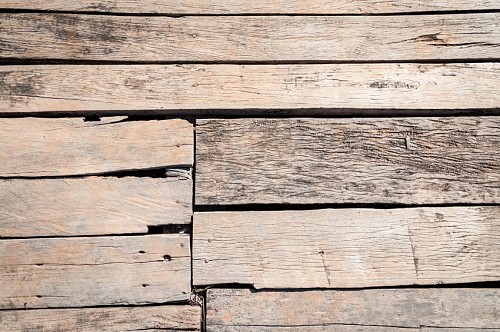Help for a Hole in a Wood Deck

Exposed to the elements as they are, wood decks tend to accumulate damage quickly, even when they’re maintained with regular coats of stain and sealants. When a hole develops in a wood deck, address it quickly, before it can become a safety hazard or speed damage to the rest of the deck by creating an opening for rot, insects, splitting, and other problems. Here are a number of ways to deal with a hole in a wood deck, depending on the cause, size, and location of the hole.
Small Hole from a Popped Fastener
If you’re looking at a small hole left behind by a popped nail or screw, check it out closely to determine if the fastener came out because of rot. If it did, you may need to replace the whole board, because just replacing the fastener won’t solve the underlying problem. If the wood looks healthy (be sure to inspect both sides, because rot can hide on the underside), apply a new screw to seal the hole and refasten the board, ensuring it won’t start to buckle or curl in temperature extremes.
Small Knothole
Holes can also develop when knots fall out, especially if cheap wood was used in deck construction. While wood with knotholes is generally not recommended for use in decks and support railings, a few may crop in. For small holes, you’ll need to embark on a multi-day wood filling project. Start by sweeping the entire deck clean, and then apply wood filler to the hole after mixing it in accordance with the directions. Fillers come in both tubs and tubes, and a tub with a spatula can be the easiest way to fill a hole in a wood deck.
Let the filler set a full 24 hours before you sand it even with the deck. If you’re a perfectionist, wait another 24 hours and sand a second time, because wood filler tends to expand slightly as it cures. Once the filler is smoothed down with sanding, sweep the deck again and stain it. The wood filler will take the stain, although it may be slightly off color when compared with the rest of the deck. If the difference is noticeable or annoying, try applying a slightly darker stain just to the wood filler so it will match up.
Larger Holes
For larger holes, you have two options. One is to replace the entire board. This is a good idea if:
- a knothole was big
- you see cracks around the hole
- or if the board appears especially weathered.
In these cases, just filling a hole in a wood deck won’t solve the underlying weakness of the board, and it will be prone to cracking with time. Alternatively, you can cut a piece of decking to match the hole, screw it in place, fill in the gaps with wood filler as above, and then re-stain the deck.
Holes from Bugs, Rot or Fungus
If you notice a hole in a wood deck that’s clearly caused by insect activity, rot, or fungus, you’ll need to take more aggressive action. Remove the damaged board and check neighboring boards to see if the problem has spread: if it has, take those out too. Also examine the joists and other supports underneath the deck, because if they’re not in good condition, you need to replace them too.
Develop a list of the wood you’ll need to replace and head to a hardware supply store. Look for hardwood with a firm, tight grain, and no knotholes. Kiln-dried lumber, which tends to be more expensive, can be a good choice because it’s extremely strong. Other lumber is less pricey, but you’ll need to set it on the deck for several days to let it get accustomed to the environment before you install it. If you don’t, it may buckle or bow after you screw it down, which can damage the deck.
Replace your damaged decking material with the new boards. Seal joists before you install them so they’ll be protected against the elements, and plan to stain the deck once you’re all finished to protect your new boards and help them blend in with the existing deck material. Keep up with your inspections and staining to keep the deck in good condition and spot holes early.
Pest Control
If a hole in a wood deck is caused by insect activity, there’s an additional step you must take after you repair the hole so people can walk safely on the deck: Determine which kind of insect was involved and take some pest control measures. Make your deck less appealing with stains and sealants, and also address issues like exposed untreated wood that could be drawing insects. It’s also advisable to keep plants cut well back from both the deck and your home so they don’t become a harbor for insects. You may need to find a pest control expert if you have a particularly bad infestation.
s.e. smith writes for Networx.com.
Updated January 29, 2018.
Looking for a Pro? Call us (866) 441-6648

Carpentry Average Costs
Carpenters Experiences

No Budget For A New Deck This Year? Try This Affordable Option

My Son’s Stamped Concrete Patio Was A Fast Track, Quality Job



